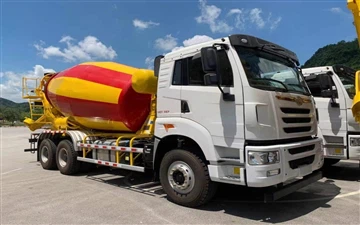Everything You Need to Know About Grapel Trucks

Grapel trucks represent a significant development in transportation technology, especially tailored for the agriculture and construction industries. With their unique design and functionality, they are becoming increasingly popular. This article will delve into the world of grapel trucks, exploring their features, benefits, types, maintenance, and much more. Whether you’re a farmer, contractor, or just curious, this comprehensive guide will provide valuable insights.
What is a Grapel Truck?
A grapel truck is a specialized vehicle equipped with a grappling arm or claw used for loading and unloading bulk materials. These trucks are particularly useful for handling large and heavy items, enhancing efficiency in various industries including agriculture, forestry, and construction.
Key Features of Grapel Trucks
- Hydraulic Systems: Grapel trucks utilize hydraulic power to operate the grappling arm, allowing for precise control and handling.
- Versatility: They can manage various materials, including logs, bales, debris, and construction materials.
- Enhanced Stability: Many models come with stabilizers to maintain balance, especially when lifting heavy loads.
- Durability: Constructed with robust materials, grapel trucks are designed to withstand rigorous working environments.
How Grapel Trucks Work
The operation of a grapel truck combines driving capabilities with heavy lifting. The truck is generally equipped with a powerful engine that drives its wheels while hydraulic mechanisms allow the operator to maneuver the grappling claw.
Understanding the Grappling Mechanism
The grappling arm typically consists of two or more claws that open and close to grasp materials. The hydraulic cylinders control the movement, enabling precise positioning. Operators can use the following methods to improve efficiency:
- Practice Smooth Movements: To avoid dropping materials, practice smooth transitions in lifting and placing objects.
- Load Distribution: Balance the load evenly to prevent tipping.
Types of Grapel Trucks
There are various types of grapel trucks, each designed for specific applications. Understanding these can help you choose the right one for your needs.
1. Agricultural Grapel Trucks
These trucks are commonly used for lifting and transporting hay bales, feed, and farm equipment. They are often lighter and designed for rough terrain.
2. Construction Grapel Trucks
Designed to handle construction debris, these trucks are more robust and equipped to deal with heavier loads. They are vital during building and demolition projects.
3. Logging Grapel Trucks
Specially modified for the forestry industry, these trucks have longer grappling arms to handle larger logs and timber effectively.
4. Multi-Purpose Grapel Trucks
These versatile trucks can switch between various applications, making them a cost-effective choice for businesses involved in multiple sectors.

Benefits of Using Grapel Trucks
Investing in a grapel truck can bring numerous advantages to your operations.
1. Increased Efficiency
With the ability to quickly load and unload heavy materials, grapel trucks significantly reduce transportation times.
2. Reduced Labor Cost
Automating the lifting process decreases the need for manual labor, allowing you to allocate your workforce to other productive tasks.
3. Enhanced Safety
Grapel trucks offer more control when handling large loads, minimizing the risk of injury associated with manual lifting.
4. Environmentally Friendly
Modern grapel trucks are designed to be fuel-efficient, reducing carbon emissions compared to older models.
Factors to Consider When Choosing a Grapel Truck
Selecting the right grapel truck for your needs can be a challenging experience. Here are some factors to consider:
1. Load Capacity
Evaluate the maximum load you need to carry. Grapel trucks come in various capacities, so choose one that matches your requirements.

2. Terrain Compatibility
If you plan to use the truck in rugged terrain, consider models with better suspension and traction features.
3. Hydraulic Power
Look for trucks with advanced hydraulic systems that offer smoother operation and higher lifting capabilities.
4. Price and Budget

Identify your budget and compare different models within that range. Factor in long-term maintenance costs as well.
Maintenance Tips for Grapel Trucks
1. Regular Inspections
Conduct regular inspections of the hydraulic system, tires, and the grappling arm to identify potential issues before they escalate.
2. Proper Lubrication
Ensure all moving parts are adequately lubricated to minimize wear and tear.
3. Cleaning
After heavy use, clean the truck to remove dirt and debris, which can affect performance over time.
4. Follow Manufacturer Guidelines
Always adhere to the maintenance schedule and guidelines provided by the manufacturer for the best results.
Practical Examples of Grapel Truck Usage
To further illustrate the functionality of grapel trucks, let’s look at a few practical applications:
Example 1: Agricultural Efficiency
A farmer utilizes a grapel truck to efficiently load hay bales onto a trailer. This process, which once took multiple hours with manual labor, now only takes a few minutes, thereby saving both time and labor costs.
Example 2: Construction Site Cleanup
During a recent demolition project, a contractor used a grapel truck to clear debris quickly. The rapid loading feature allowed for the site to be cleared and prepared for new construction in record time.
Example 3: Logging Operations
A logging company integrated grapel trucks into their daily operations, revolutionizing the way they transport logs from forest to processing locations. This efficiency not only increased productivity but also reduced fuel costs.
Cost Factors Associated with Grapel Trucks
Understanding the costs associated with grapel trucks can help you determine your budget. Key factors include:
1. Purchase Cost
The initial cost of the grapel truck depends on its type, features, and brand. Be prepared for a wide range of prices.
2. Maintenance Costs
Regular maintenance and parts replacement can add to your long-term costs. Make sure to account for these in your budget.
3. Fuel Efficiency
Considering the fuel efficiency of the truck can significantly impact operational costs, especially if you plan to use it frequently.
Frequently Asked Questions (FAQs)
1. What is the average lifespan of a grapel truck?
The average lifespan of a grapel truck can range from 10 to 15 years with proper maintenance.
2. Can grapel trucks be used for indoor operations?
Yes, grapel trucks can be used indoors, but it’s essential to ensure enough space for maneuvering and unloading.
3. What training is required to operate a grapel truck?
Operators typically need a valid commercial driving license and specialized training to handle the hydraulic systems and grappling mechanisms safely.
4. Are grapel trucks suitable for small businesses?
Yes, small businesses can benefit from grapel trucks, especially if they handle heavy materials regularly. Compact models are available that are cost-effective for smaller operations.
5. How do I choose the right grapel truck for my business?
Assess your specific needs, including load capacity, terrain compatibility, and your budget, to choose the right model for your business.
6. What are common issues with grapel trucks?
Common issues include hydraulic leaks, wear on the grappling arm, and electrical problems. Regular maintenance can help mitigate these issues.
